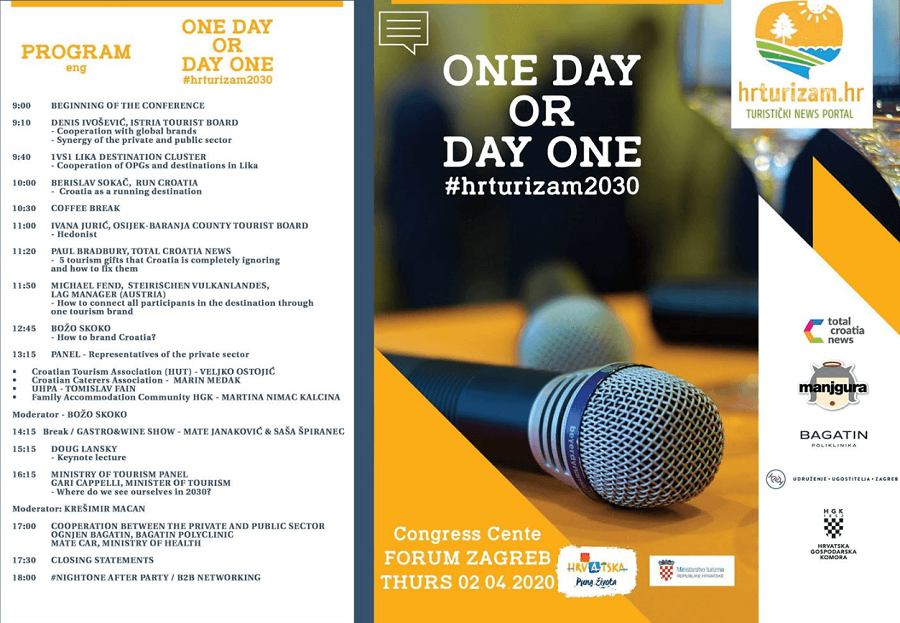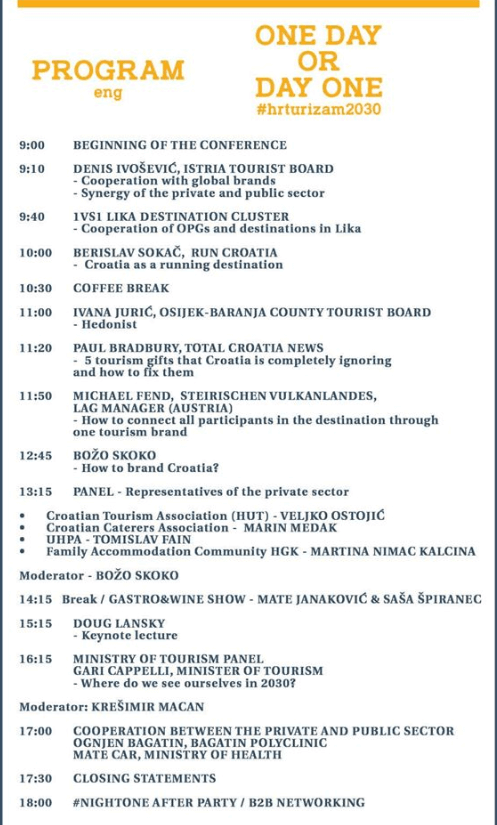No Stress – Being Fit Is Your Success: 5th Adria Business Network Announced
February 20, 2020 - The fifth Adria Business Network, organized by entrepreneurs Željka Barišić and Kristina Krstinić, will be held on March 4, 2020, at 6 pm at the FORUM Zagreb Convention Center.
To lead the first part of the event, the guest lecturer is a new generation fitness trainer and owner of the brand BE FIT - Marko Loncar. We are aware of how much work and daily stress can affect our diet, lifestyle, and thus our health. Keeping top form and avoiding potential burnout is a challenge for us all.
Thus, at this Adria Business Network event, participants will learn what is required for proper nutrition and superior health in the business world. Marko is a columnist for Men's Health and Vecernji List and an ambassador for many companies. He has lectured at numerous seminars and workshops at major conferences in the region, schools, and companies. He is a longtime author and guest in numerous media. He is also an influencer with over 80,000 followers on Facebook and Instagram. Marko’s lectures are always packed to the brim.
The second part of the event follows with the one-minute pitch presentations of all present.
Finally, in an informal gathering with quality wines from the sponsors, everyone will have the opportunity to exchange their experiences with the guest lecturer and other participants.
Seating is limited and you can secure your spot on time by registering here.
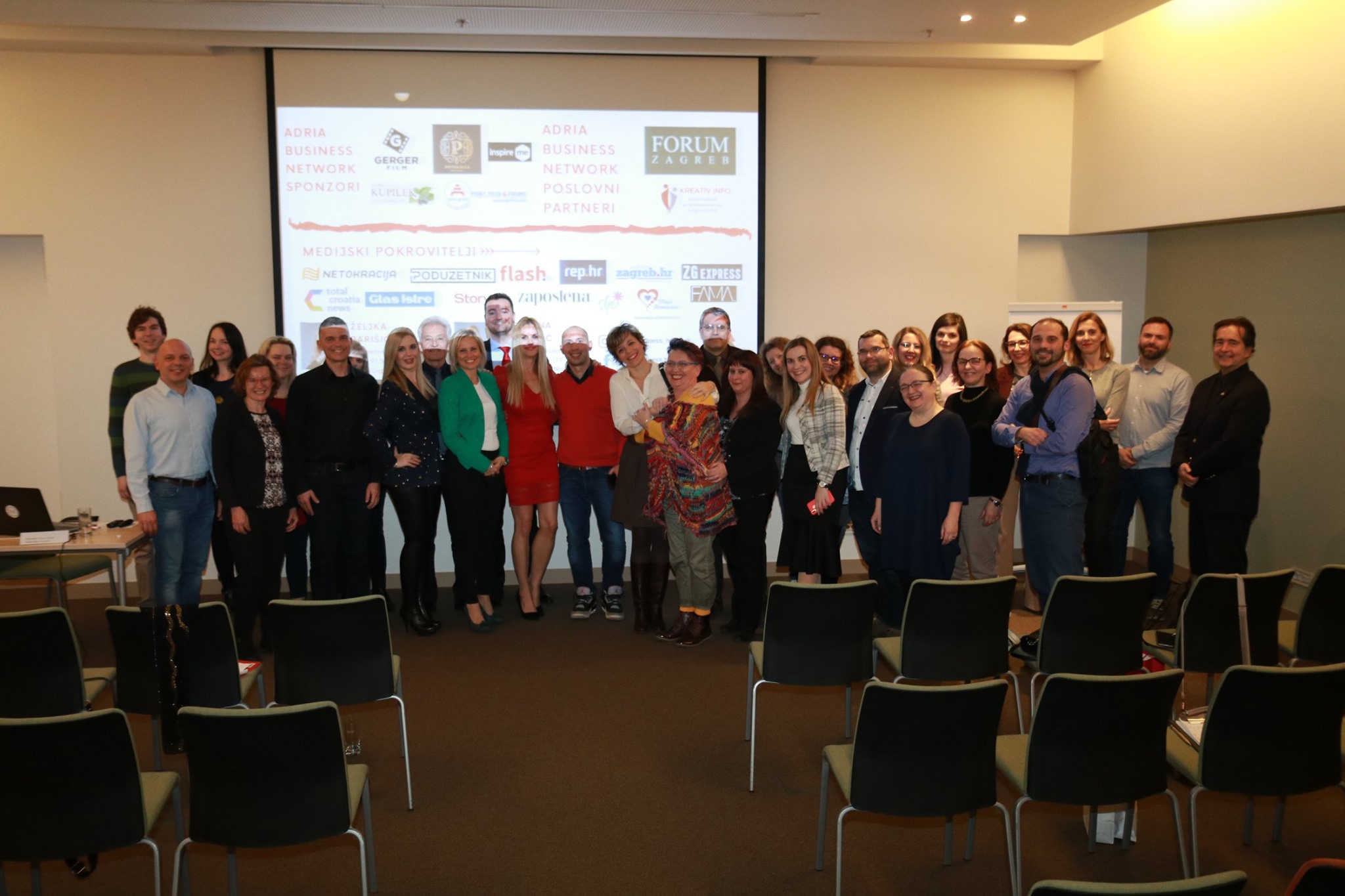
The general sponsors are Bagatin Clinic and FORUM Zagreb Convention Center.
Adria Business Network is conceived as a networking event for business people in Croatia and the region, creating business opportunities and encouraging continuing education. Through the event, participants are offered the chance to find new clients and enter into lucrative business deals.
The event is organized in such a way that the guest lecturer speaks for 30 minutes, followed by a pitch (i.e., personal presentation) by the event participants, which is 60 seconds per person, and up to 60 minutes in total. This is followed by time for socializing and networking, where guests can enjoy the perks of attractive sponsors. The guest speaker selection is always in line with the latest market trends.
The brains behind the event are Željka Barišić and Kristina Krstinić.
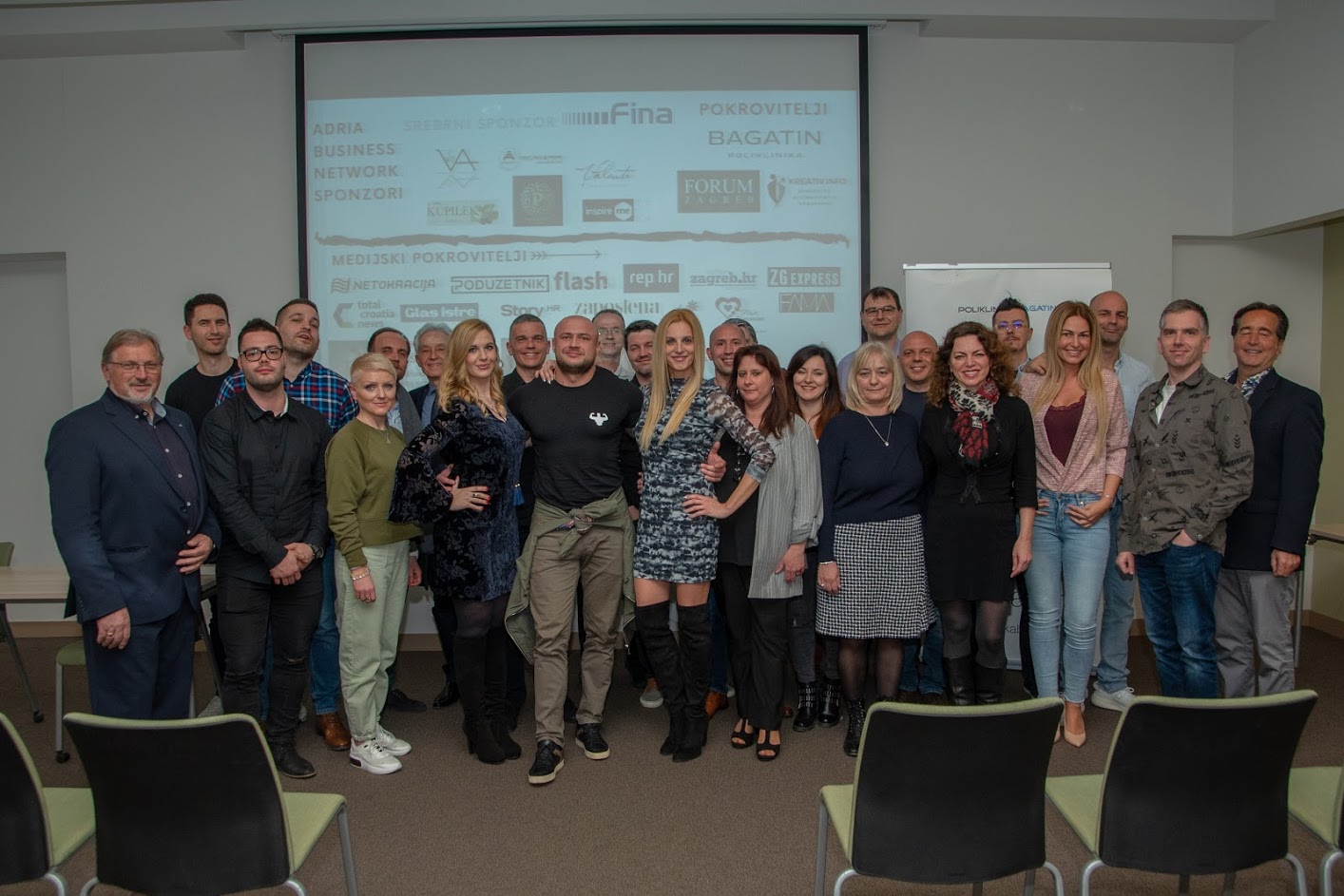
Adria Business Network takes place every month and lasts 3 hours. You can learn more about Adria Business Network here.
To read more about business in Croatia, follow TCN’s dedicated page.
Flights to Croatia: Emirates and Korean Air Resuming Seasonal Routes to Croatia
February 19, 2020 - After a five-month break, Emirates and Korean Air will resume their seasonal services to Croatia next month.
Namely, Ex Yu Aviation reports that Emirates will once again fly to Zagreb on March 29, on the route that has been operated by Flydubai for the winter. Ex Yu Aviation adds that the Zagreb service was the first time these two airlines shared a single route.
"Zagreb is an example of how much our cooperation with Flydubai managed to improve our results. We served the route in winter with our Boeing 777 aircraft. However, it emerged that this route is not as strong in winter, so now we can still continue serving Zagreb well through Flydubai,” said Emirates’ Area Manager, Martin Gross.
“Zagreb is corresponding with our development in Europe. We have wide coverage in Europe, and we understood that Croatia has big potential for two reasons. First, it is a destination that is really interesting for travel from Asia, Australia, China and Taiwan. Therefore, there is a lot of incoming traffic to Zagreb and the entire country in general. From Croatia it is a way to offer the local population a link to our Dubai hub. There is a lot of demand from Croatia to the world. This is primarily to Dubai but also beyond, for example, to destinations in the Indian Ocean and Southeast Asia, such as Phuket in Thailand”, Emirates said about the future of the Dubai - Zagreb service.
We will also see the return of Korean Air to Zagreb from March 31. The airline will increase capacity on this route this year and use the Boeing 787-9 Dreamliner, which has capacity for 269 passengers. Korean Air will run on the Seoul-Zagreb route three times per week.
Recall, Korean Air previously ran year-round to Zagreb, though it cut back its winter operations in 2019.
“We have not yet decided whether suspending the flights during the winter season will be continued in the future,” the airline said for Ex Yu Aviation.
To read more about travel in Croatia, follow TCN’s dedicated page.
Pink Floyd's Nick Mason Brings Saucerful of Secrets to Main Stage of INmusic Festival 15
February 19, 2020 - The legendary Nick Mason, founder, drummer and long-time member of Pink Floyd, is bringing supergroup Nick Mason's Saucerful of Secrets to INmusic Zagreb!
Namely, Dnevnik.hr reports that Nick Mason's Saucerful of Secrets will take festivalgoers on a special musical journey on INmusic’s 15th birthday.
Creating the unique and inimitable sound of Pink Floyd, commonly described as art rock or progressive rock, Nick Mason and his bandmates Roger Waters, David Gilmour, Richard Wright and Syd Barrett became music immortals and some of the most notable musicians of the 20th century. Pink Floyd's influence is enormous, and is said to have inspired David Bowie, U2, Queen, Radiohead, Kraftwerk, Tool, Nine Inch Nails, The Smashing Pumpkins, and more.
After curating the acclaimed box set The Early Years 1965-1972, dedicated to the early psychedelic work of the cult band, in 2016, Nick Mason decided to make a full-blooded return to the scene after a historic appearance as part of a humanitarian Live 8 concert that last brought together all living members Pink Floyd.
Unlike bandmates David Gilmour and Roger Waters, whose extensive tour focuses on Pink Floyd's later works, their solo works and select early Pink Floyd classics, Nick Mason's Saucerful of Secrets returns to Pink Floyd's most innovative sound and brings a concert interpretation of the albums from The Piper at the Gates of Dawn to Obscured by Clouds performing. And they exclusively perform only Pink Floyd songs. Being a cross-section of seven Pink Floyd albums out of a total of 15 studio releases, Nick Mason offers the audience the most extensive concert experience of one of the most significant and greatest rock bands of all time.
In the words of Nick Mason himself, Saucerful of Secrets is his return to his favorite Floyd songs. Seeking to "capture the spirit of the times," Nick Mason brings together top musicians in a supergroup, such as Gary Kemp (Spandau Ballet), Guy Pratt (Pink Floyd bassist after Waters), Lee Harris (Ian Dury & the Blockheads) and Dom Beken (The Orb, Transit Kings) who authentically and vitally reinterpret Pink Pink's most challenging, productive and inventive years. The audience awaits top performances of classics that have permanently marked the modern history of music - "A Saucerful of Secrets", "One of These Days", "Astronomy Domine", "Let There Be More Light", "Green Is the Color", "Set the Controls for the Heart of the Sun, "Lucifer Sam", "Arnold Layne", "Bike", "Fearless", and more.
The exclusive four appearances in London in May 2018 were followed by a sold-out European and North American tour that brought the sound of early Pink Floyd to some of the most prestigious stages in the world - from a celebratory concert at the London Roundhouse, Paris Olympia, Philadelphia The Metropolitan Opera House, to the ancient amphitheaters of Lyon and Sicilian Taormina, and the just-announced performances at the Berlin Tempodrome and London's Royal Albert Hall scheduled for May 2020.
All lovers of Pink Floyd, rejoice! You won’t want to miss this year’s INmusic in Zagreb.
To read more about lifestyle in Croatia, follow TCN’s dedicated page.
How Croatian Youth Can Change Lives and Shape Minds with Erasmus+ Projects
February 17, 2020 - There are many opportunities for young Croatians to broaden their horizons, which are not being fully utilised. A look at Erasmus +.
Even though Croatia has been part of the European Union for almost seven years, many of its citizens have yet to realize the full potential of all the programs the EU has in store for us. The young are probably familiar with the Erasmus+, which is organized between Universities and which allows them to spend the semester or a year abroad. The problem with many Faculties in Croatia is that it gives very limited options to its students when it comes to subsidizing their subjects, and most of them, in the end, decide not to go. The reason behind it is that they would probably have to redo the year at their home University.
But, there is an option for students with the limited time that would like to experience traveling abroad, exchanging cultural similarities and differences with their peers, and still learn something new and useful. It's called the Erasmus+ project, and it seems to be taking Europe by storm. The same cannot be said for Croatia, though, where there are not as many NGOs that are actively working on connecting the youth with the projects offered.
Let's start with the introduction and explanation of what an Erasmus+ project is. It is part of the larger, Erasmus+ program comprised of various plans related to education, training, youth, and sports. At the beginning of the decade, the European Commission was trying to find the solution to the growing problem of unemployment, particularly among young people. Their way of combating the challenge was to ensure that the young are getting skills that are not only explicitly related to their University education but rather will endure through all the hardships of the future.
One of the hardships Europe dealt with from 2014 onwards was the influx of migrants coming from disadvantaged backgrounds and, by creating this chain of projects, they managed to raise the youth that is more understanding and has a higher sense of belonging to a community no matter how much that community differs from the one they were raised in. Other than that, the goal was to raise the youth willing to fight for what they stand for, and that is courageous enough to participate in society and the creation of democratic Europe actively.
They managed to do it by creating a well-organized education and training system which provided people with skills required by the labour market and the economy of the 21st century, pushing them to play an active role in society and, in the end, achieving personal fulfillment. Its first round started in 2014 and was supposed to end by the end of this year but will instead be extended for another seven years. All the projects were funded from the European Commission budget. The 14.7 million euros were used to pay for the accommodation and food for the participants as well as people in charge of the project, and realization of the project itself. The new round is projected to cost the European Commission more than 3 billion euros.
Fortunately enough, there are groups of people in Croatia that are using their own private time and resources in order to notify the youth of all the projects. One of them is Mateo Papić, co-founder and president of the NGO Institute of Youth Power Croatia, which was established in February of 2018. People that helped start it were Karla Silic, Dea Botica, and Leo Bartolec.
When asked how he came up with the idea of founding a non-government organization whose purpose will be to connect young Croatians with passion for previously mentioned causes and Erasmus+, Mateo was quick to answer.
"I had been on a few projects with the informal youth group from 2016 to 2018, and in the beginning, it was all about fun and getting experience from various people all around Europe. Somewhere around the end of 2017, a friend of mine, Leo, asked me to take the leadership of the informal group, and I took a challenge upon myself. Even though there were some difficulties in the beginning, few people decided to drop out, and in the end, it was all left on my shoulders, near the end of 2018, the NGO really kicked off. The Institut of Youth Power Croatia was born."
In the meantime, Mateo used all of his free time to participate in projects, learn about the Erasmus+ itself and meet a lot of people from all sides of Europe. He used that experience to connect with various other organizations, and that is how other members of IYP started participating in projects.
When it comes to explaining why his peers are not following his lead, he says Croatians don't have a mentality of going to projects and then, upon return, promoting it to their friend as something educational. Instead, most Croatians are focused on the destination and the fact that Erasmus+ projects are also famous for their parties.
"One of the key reasons I was eager to start working on developing the organization even further is the fact that it gives a fantastic platform for all the participants. One of the policies we have in our organization is that every participant has to write an honest review of the project. Then we promote it through our social media, and more people see how amazing it is to participate. "
Another problem is the lack of understanding from high-school and college professors when it comes to absences students collect during the time of the project. Once teachers become more lenient, and students realize that it is better to spend an absence on the project than on a coffee with a friend, the Erasmus+ projects will see more Croatians actively participating.
"Last year alone, we send over 150 people on projects and seminars. Seminars are great for people who want to write their own project and create an even more significant impact on the European community."
In the end, Mateo talked about some of his goals and how he sees himself in the next few years.
"There have been some rumors which suggest organizers of the NGOs might be getting paid in the next phase, starting from 2021. That would give us an amazing head start and could be helpful when trying to construct some projects for the participants to come to us. Just last week we submitted an application for five projects with our partners and friends from Bosnia and Herzegovina, Armenia and Bulgaria. We really hope some of them might get selected. That would put our organization on the map with other successful organizations in Europe. Our motto is always striving for the best and highest goals and not giving up until we get there. This can be achieved only happen if every single one of us thinks for themselves and decides what they deem necessary enough to put all the effort into."
Whether it is due to meeting new people from different parts of Europe and, thus, often entirely new cultures, working on oneself and contemporary skills, or just free traveling, one thing is for sure, those that go and experience an Erasmus+ projects, fall in love with it entirely.
The motto of the Erasmus+ is changing lives and shaping minds. It perfectly illustrates all the benefits of participating. If you want to join and learn about yourself as well as about different European cultures and also have fun on the way, check the new webpage Institut of Youth Power Croatia and change your life.
And if you want to know more about the Erasmus+ guidelines and program guide, you can check out their official webpage.
Promoting Croatian Tourism Through Film: Spomenka Saraga Interview
February 17, 2020 - Meet one of the unsung heroes of Croatian tourism promotion and learn how Spomenka Saraga is using film to showcase Croatia and its location filming potential.
Tourism arrivals from South Korea have soared in Croatia in recent years, from just 16,000 to over 400,000. Rather than this being part of a coordinated official strategy, the main reason was due to the popularity of several Korean reality TV shows which
Spomenka Saraga is director of her own production company called Balduči Film. She has won numerous awards for her tourism films and she is director of the Zagreb Tourfilm Festival, which is the international festival of tourism film that is held in Zagreb.
Where did you get your love of film?
My love for films was determined by the place I was born. I was born across the road from the legendary Jadran Film production company and from early childhood, I saw actors and later I would see them on TV. So in a way they were my neighbours. At that time Jadran Film produced a lot of American films. It was of course Yugoslavia back then, and when the actors went to buy some things, a lot of people didn't recognise them. People lived more relaxed lives back then and when they walked around the town in those costumes it was very interesting to see.
I started working in Jadran Film and soon decided that documentary film was the niche which interested me. Within documentary films, I started to love tourist films and that love has lasted until the present day. Then the love for tourist films became a love for travelling.
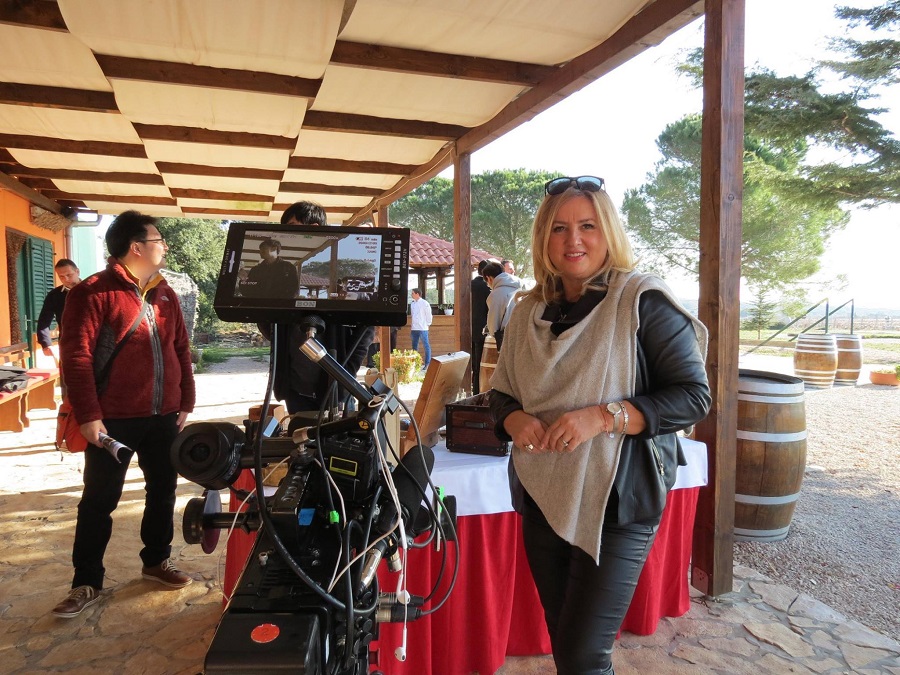
Credit: Spomenka Saraga
According to you, what does a good tourism/travel/promotional film has?
A good promotional film has to show a location in its natural way. The film has to have a target to the which public is intended. While working with a tourist board I always ask them what is their target age of tourists. Are those older people, couples, families, young people and what do you want to show tourists? Sometimes you can cover the whole age group. But it depends if the attraction and location can cover it, like Rijeka.
In our last film about Rijeka, we addressed people from Europe, people from Croatia to visit Rijeka, which is the European Capital of Culture for 2020. In that film, we wanted to address everyone. We wanted them to come for one or more days in Rijeka or simply spend their vacation there. Rijeka is a big town but also has beautiful beaches. They can also find great accommodation and go on excursions outside of Rijeka.
The most important thing about good promotional films is that the clients know what they want. Locations are different in their way. You can't address young people and families with children with the same location. Young people want to go out in clubs, loud music, dance and that is different what families want. Families want peace. The second important thing is the music. A lot of clients told me that music is not important. We choose music to fulfil all the criteria. Even our Croatian authors are now making great music, which follows global trends.
In Rijeka I Miss You, you covered things for young people as well.
Yes, because a town like Rijeka has it all. You have bars, night clubs for young people. Also, there are restaurants, both fast food and restaurants with good food, because it is a big town. The same goes for Split and Zagreb as well, or any other bigger town. Right now city breaks are modern. People come for a couple of days and they come with direct flights. Towns need to have good connections with destinations. It is great when you can come in the morning with your flight and then spent a few days and then catch a night flight. That is very convenient for young people and business people.
What can you tell us about Balduči Film?
I worked in Jadran Film for over 30 years and unfortunately that firm was destroyed like many others in Croatia. Before the Homeland War, Jadran Film was one of the best production companies in Europe. They even called it Little Hollywood. We had studios, laboratories and we did great films, such as Night Watch, Death Train, Sophie's Choice, Fiddler on the Roof and some of these films got an Academy Award.
Because of the combination of these circumstances in the firm, I asked myself what now? I only knew how to work with films, so I decided to open my own production company. I can proudly say that in almost 13 years, my company hasn't had any debt or problems. The company produces tourist films but also offers foreigners which come to shooting in Croatia for reality shows from China, Korea, England, the United States, the Netherlands and more. Thanks to our production connection with Korea, today Croatia has more tourists from Asia. Not so long ago we finished a reality show with a production company from Wales. We finished six episodes for a reality show that we worked in Lošinj, where Lošinj came across as a great destination. It showed great production and we were surprised with great service. On that project, we worked with a production company from the Netherlands. In one day, we shot one episode and we finished in eight days and preparation lasted for five days and it all went perfectly.
We also shot the second season of PTSP: Sexual harassment, the previous one was shot in Norway and the second in Lošinj. It is a great show, female patients came with their therapist, they had everyday therapies and sessions in a beautiful environment, where they enjoyed excellent nature and food which Lošinj offers. We looked through a lot of islands and destinations and Lošinj came out as the best one.
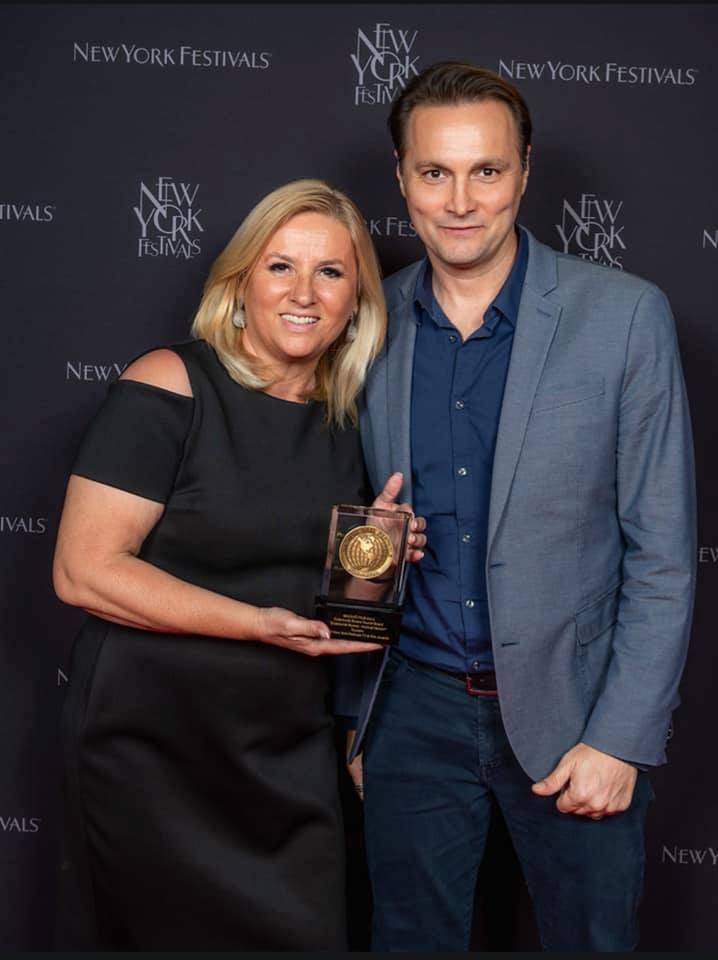
Credit: Spomenka Saraga
What do you think about Croatia as a film location?
That is also one of the segments in which I work. I work as a location scout. The first film that I made about film locations in 2006 was the only film we have ever had. This year we finished a new film about locations in Croatia and I have to thank the Croatian National Tourist Board which gave me the support. We showed the coast and continental part of Croatia. The film sadly didn't cover all the locations, it even lasts longer, like seven minutes. However, it is hard to summarize everything in two minutes and that is exactly how long they had to last. If someone wants to visit locations in Croatia, that film is a great invitation. And it also shows the diversity that Croatia has. The producer needs to have the ability to move on the ground from one location to another and Croatia has that advantage. Croatian advantages are roads. Also, for example, Makarska has mountains which are very close to the sea. Split also has harbour from which you can quickly come to islands.
CROATIA YOUR NEXT FILMING DESTINATION from Balduci Film on Vimeo.
Dubrovnik is so beautiful and whenever you turn your camera you can't go wrong. The problem of shooting in Dubrovnik is that they are too many tourists. To shoot in Dubrovnik, you have to close the town and that is very hard. So you have many night scenes. This year the town has started paying to use the location for films because sometimes damages can happen or pollution, but the team of filmmakers clean it. The citizens of Dubrovnik are proud of the fact that famous productions are made there. That is a great promotion of not just Dubrovnik, but all of Croatia. With this movie about film locations of Dubrovnik, we want to call film producers to visit and use other places in Croatia.
Mamma Mia 2, was shot in Vis, but the first part in Greece. When I was in Greece at a congress where I had a lecture on How a film location can be a tourist attraction. A the end of the lecture, many people admired how Croatia managed to get that. But they were also angry because Vis portrayed a Greek island. In the films, we have a problem that Croatia often doesn't represent itself, but other countries. I agree that towns should play real towns, like when we shot in Rovinj and Šibenik and they played their real towns. That is a good thing for the promotion of films and locations for films are cheaper and sometimes they can be free. But if the town represents the other town, the rent for the location of the town should be paid.
We have a commercial for Heineken in Rovinj with a James Bond then. First, it is showed Rovinj and then you see it is a commercial for a Heineken.
You have produced a lot of films about Dubrovnik over the years
In the last 30 years, I worked with Branko Baureom which came from the production company Jadran Film. The first film that was shot in Dubrovnik after the war, was Dubrovnik Riviera that worked Baldo Čupić. The first film that I worked with my production company is Unique Dubrovnik, after that Dubrovnik and Time. Eleven years ago I made a film whole Dubrovnik Riviera and it is called Magnificent Jewels. That is a film about Dubrovnik county
Last year we made a film Dubrovnik Riviera, which won nine awards. We even won two American awards. One of them is Telly awards and we won third place in the New York Film Festival.
DUBROVNIK RIVIERA - FV from Balduci Film on Vimeo.
For what film it was a great honour to win?
Every movie is a great honour, but when great festivals get to know your work. Visit Lika won a silver award in America, second place in Riga, an award in Portugal. On that film, I worked with director Boby Grubić, who won three Emmys. In order to make a great movie it is important to know what people like, what clients like, and how to reach to them.
VISIT LIKA from Balduci Film on Vimeo.
Dubrovnik is a great love for me, I love Dubrovnik like I was born there. For American filmmakers, I showed them new script and locations which would be good. At first, they weren't interested, because they had their own standard story of Dubrovnik. But overnight they liked my idea and they were excited. They saw a sea egg and Stone walls. It is great that part of the county is preserved and that people look after it.
How does the promotion of Croatia around the world look like?
A lot of people who do not know people from Croatia or have never been there, see Croatia in a bad way. When they see film or hear stories, they think that we are a small, poor country. When I show people tourist films which are different than documentary films and news video, where they saw a situation in Croatia, people are very surprised when they see how great it looks. They say that we are a real European country. A country with a great sea, nature, and they are surprised by our roads. How quickly they can go from one place to another. Of course, they are thrilled with Croatian National Parks, because for example in Plitvice lakes people love nature and waterfalls. Many people come to Croatia and they don't dare to drink our water because they think is polluted. They would rather buy it. But we can be proud because we have clean water. Croatia has a lot of stuff to offer. It is a beautiful country, with nature and fresh air. We should consider the price and quality. It is not a problem to pay if that price satisfies the quality. When you go to other countries, you pay a big price for a meal, but you get a quality one. During the winter we keep our hotels closed, but I think if we give lower prices, we would have tourists then too.
How long does it take to make a tourism film?
The idea of what to shoot takes most of the time. After we decide what do we want to shoot, then things go smoothly. The most important thing is the preparation. When you make a film, it is important to make more plans, because you depend on the weather, so I always have Plan A, B, C. So if Plan A or any other doesn’t work, I always have a backup. It can often happen that we make a film and then we change the concept. For example, in Dubrovnik Riviera, we changed the music, because we thought it would go better than the previous one. We are always careful when we choose the music, we want it to go to the pictures and that the client likes it. If you want to make a low-budget film, the minimum is five days. But if you want to make a quality film, you have to have time for that. The optimum time for that is eight to ten days or more. It depends on the location and the places which you have to visit. When we make it, we pick the best cadre and after that, the editing is done very quickly. It takes about five days, but it depends on the length of the film. Sometimes you have to have colour effects because you don't work under the same conditions. But when you look it from the start, the beginning, organizing, the script, it takes let’s says two months.
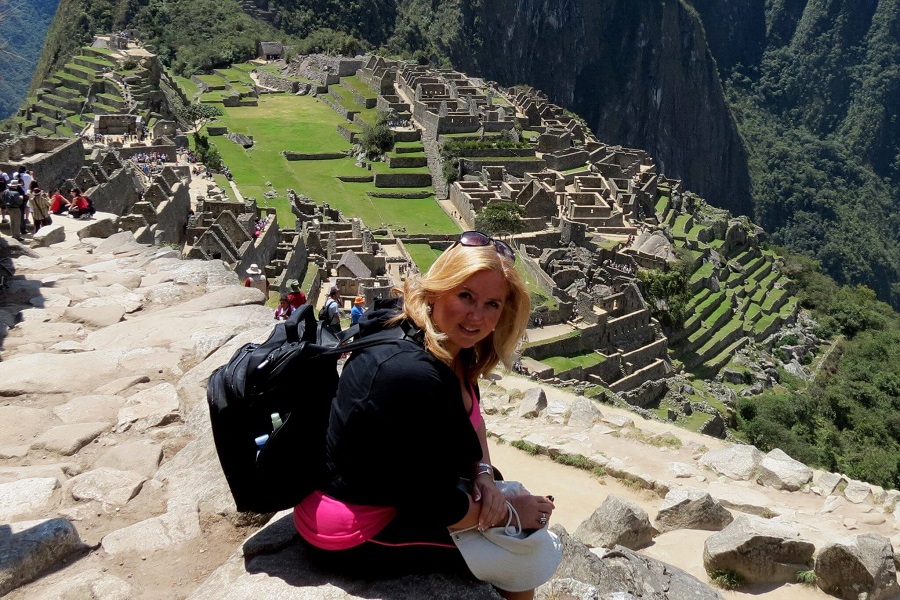
Credit: Spomenka Saraga
What do you think about Croatian film festivals?
Croatia can be proud of its festivals and hospitality. Festivals always offer people to stay, food, they make great organization and welcome them. From day one, we want to make their stay very beautiful. Some people are shy and we make sure to connect them to other people, so they don't feel bored or left out. We always want to feed our guests well and many guests from other countries are very surprised when they find out that food on such events is free. In other countries, if you want to eat something, you have to pay for it.
In the Sarajevo film festival, they work hard to satisfy their guests and that is the reason why it is one of the best festivals in Europe. In a short time, it became a great festival like one in Cannes and Venice.
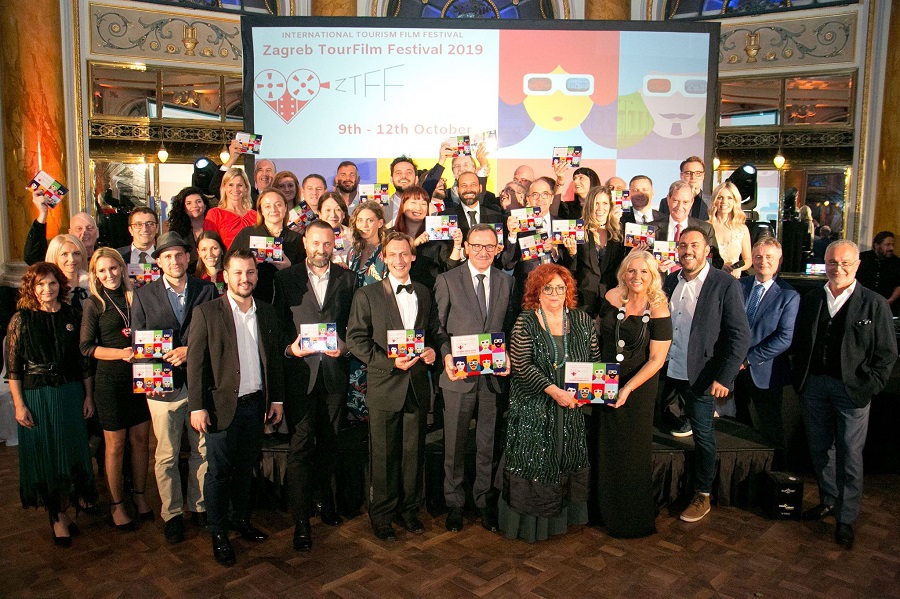
Credit: Spomenka Saraga
Tell us a little about Zagreb TourFilm festival?
Organizing such an event is not that simple. We owe a debt of thanks to Amelia Tomašević, the previous director of the Zagreb Tourist Board, who saw potential in the promotion of tourism through such festivals. In a way, she was a co-organizer. Later we continued working with Martina Bienenfeld, the current director of the Zagreb Tourist Board, which supported the festival because it is a mutual festival between Zagreb Tourist Board and Balduči film with other sponsors as well. My experience at other festivals allowed me to see what is good and bad. In the first year, we set the bar very high, so later it was really hard to surpass that. With the help of Luka Benko, from Zagreb Tourist Board and Niko Bulić, the previous director of Croatian National Tourist Board, we made a great festival. Every guest praises the festival, as it can be seen in the reaction of the quests, which come for the first time, or they have been here. Also, ambassadors in Croatia show satisfaction about the festival. They are amazed how their country gets promotion through the festival, they are happy that their film was shown to the Croatian people.
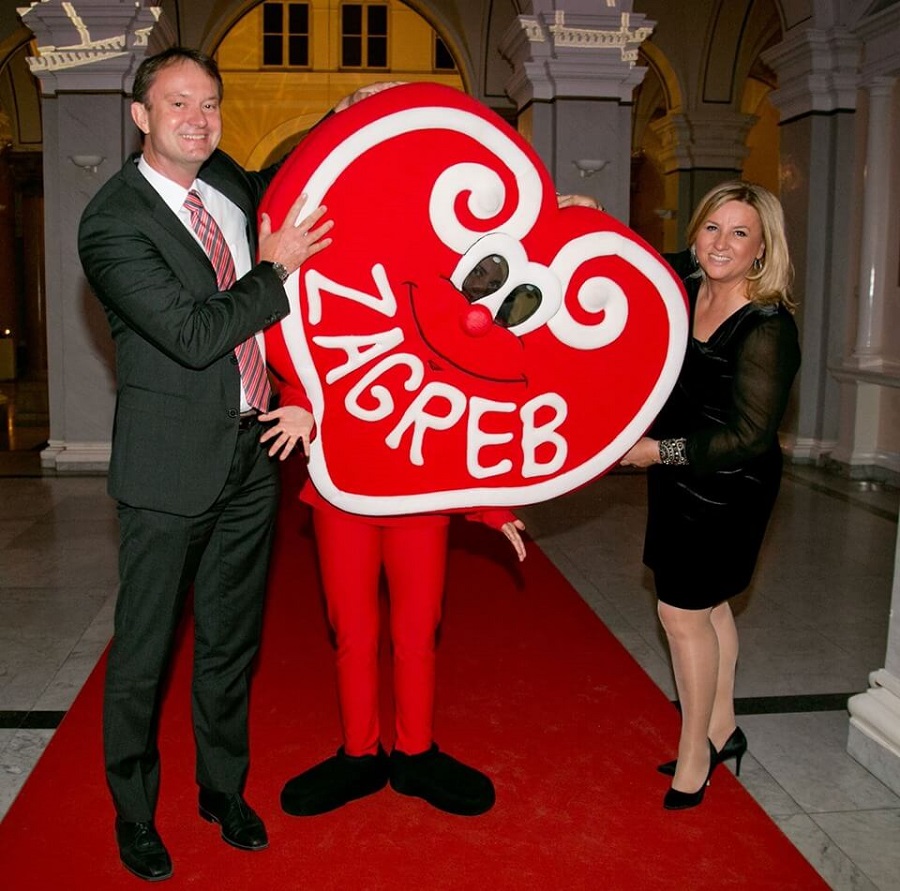
Credit by: Spoemnka Saraga
The benefit from these festivals is that journalists in countries that won the award are writing about it. We have a lot of articles abroad, for example in Japan. We recently got information that fifty portals have written about a film and their director who won an award in Zagreb. So that is the promotion of the town and country abroad. Sometimes people come to the festivals for three days, but they often extend their stay for a week or even more.
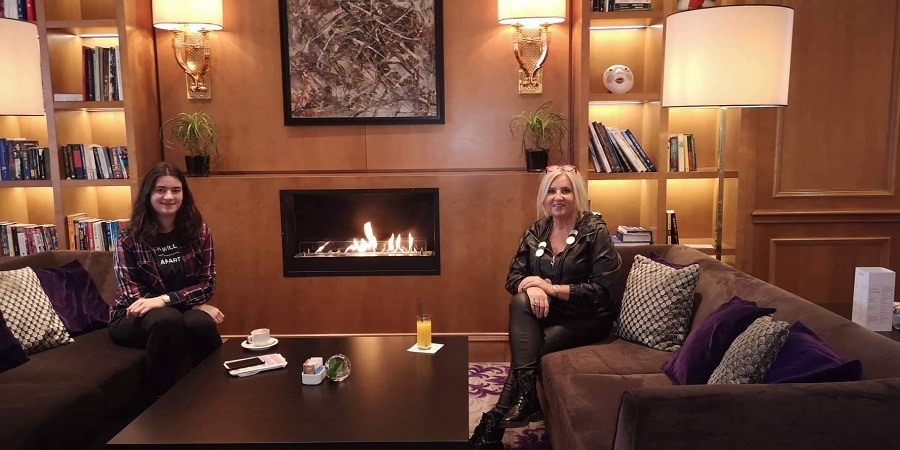
HNL Round 22 Recap: Dinamo Falls to Osijek, Belupo Better than Hajduk
February 17, 2020 - The 22nd round of the Croatian First League was held from February 14 to 16, 2020. Dinamo recorded their second defeat of the season, while Hajduk struggled against Slaven Belupo once again.
Lokomotiva v. Istra 1961 (2:0)
Lokomotiva and Istra opened the 22nd round on Friday, February 14, in Zagreb in front of 320 fans.
While the first half went without goals, Lokomotiva’s Uzini scored in the 63rd and 67th minutes for 2:0, which was the final score of the game.
Lokomotiva is currently in 5th place with 34 points, while Istra is in 9th place with 15.
Inter Zapresic v. Varazdin (1:2)
Inter and Varazdin met in Zapresic on Saturday, February 15, 2020, in front of 2,045 spectators.
Inter was in the lead first thanks to a goal by Serderov in the 19th minute for 1:0 at the half.
Benko equalized for Varazdin in the 60th minute, and Petkovic gave them the lead in the 70th minute for a final score of 1:2.
Inter is currently in 8th place with 17 points, while Varazdin is in 10th with 15.
Slaven Belupo v. Hajduk (2:1)
Belupo and Hajduk met on Saturday, February 15, 2020, in Koprivnica in front of 2,912 spectators.
Hajduk was awarded a penalty early the game, which Eduok scored for the lead (0:1). However, a double yellow for Juric in the 37th minute saw Hajduk play with a man down for the rest of the game.
Bacelic-Grgic equalized just before halftime for 1:1.
Krstanovic scored the winning goal of the game in the 88th minute for the Belupo victory.
Belupo is currently in 7th place with 21 points, while Hajduk is in 2nd with 41.
Osijek v. Dinamo (1:0)
Osijek and Dinamo met at City Garden Stadium on Sunday, February 16, 2020, in front of 6,450 spectators.
The second half made up for the uneventful first half. First, Dinamo’s Dilaver was shown his second yellow of the game in the 67th minute, which forced Dinamo to play with a man down. In the 77th minute, Maric scored for Osijek, which gave them the 1:0 lead.
The chances for Dinamo to equalize were even slimmer once Stojanovic was shown a red card in the 4th minute of injury time, and coach Nenad Bjelica was ejected from the pitch two minutes later.
Osijek is currently in 3rd place with 38 points, while Dinamo remains in 1st with 53.
Gorica v. Rijeka (0:0)
Gorica and Rijeka closed out the 22nd round on Sunday, February 16, 2020, in Velika Gorica.
Neither team was able to score throughout the game, which ended 0:0.
Gorica is currently in 6th place with 31 points, while Rijeka is in 4th with 38.
You can see the full HNL table here.
To read more about sport in Croatia, follow TCN’s dedicated page.
'One Day or Day One' Croatian Tourism Conference Schedule Published
February 16, 2020 - The final schedule of the One Day or Day One #hrturizam2030 conference has been published, bringing together some of the top names of Croatian tourism's public and private sector.
I have never seen a conference organised from a conversation over a kitchen table to realisation before, and it has been really inspiring seeing the progress of Goran Rihelj and his indefatigable wife Mirjam to make 'One Day or Day One #hrturizam' a reality at Congress Centre Forum Zagreb on April 2.
Goran, of course, was the man whose initiative to bring Days of Croatian Tourism to Slavonia last year really put the spotlight on the potential of tourism in eastern Croatia. And now his #DayOne conference is bringing together key stakeholders in the public and private sector in Croatian tourism to focus on areas of agreement and cooperation to build a roadmap of progress for a better future for Croatian tourism.
The programme, which will be in both English and Croatian with simultaneous translation available, has now been published. Apart from the presentation by keynote speaker and acclaimed global tourism guru, Doug Lansky, there is bound to be great interest in the panel with Minister of Tourism Gari Cappelli and Croatian National Tourist Board Director, Kristjan Stanicic, discussing where they are aiming to get Croatian tourism to by 2030.
In addition to the speeches and panels, there will also be a gastro and wine show by celebrity chef Mate Jankovic and wine expert Sasa Spiranec.
And after a stimulating day, perhaps the most interesting part in terms of networking - Night One, the after-party, where there will the chance to mingle and network with the many progressive tourism professionals who will be attending, as well as meeting some of the speakers.
I am delighted that TCN is able to support #DayOne as media partners, as well as having the chance to present my own contribution, 5 Gifts Croatian Tourism is Ignoring, and How to Fix This. You can see my video message supporting the conference in the video above.
To reserve your tickets, visit the dedicated page on the HRTurizam website.
If you have any questions or need help from me, contact me on This email address is being protected from spambots. You need JavaScript enabled to view it.
Why the Zagreb Split Slow Train is Actually a Great Way to Travel
February 14, 2020 - The Zagreb train to Split may not be the fastest way to travel, but it has many advantages over the bus.
Croatian trains do not have the best reputation in the world. The network itself is fairly disconnected, and big destinations such as Dubrovnik no longer have a train station (although they used to until recently), for example, and Ploce connects only to Metkovic by rail before continuing to Sarajevo and beyond.
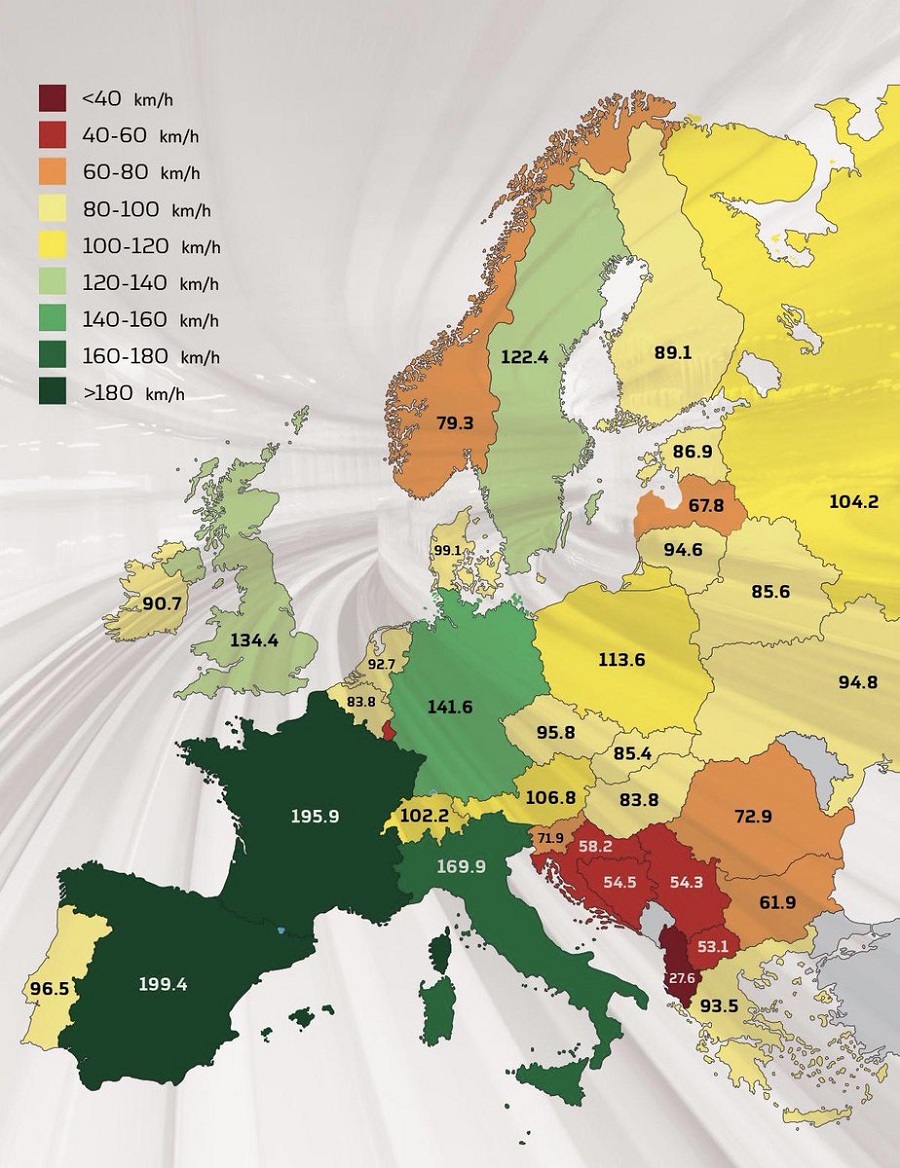
And Croatian trains are certainly not the quickest, more than three times slower that the likes of Spain and France, according to this European overview, above.
So why take the train at all?
I love trains, always have, ever since my Interrailing days in my youth, as well as those long, slow overnight journeys in the Soviet Union undercover for MI6. I had a business trip to Split this week and had to leave the car with the family, and I really could not face another 5-6 hour bus journey, so decided to give the train.
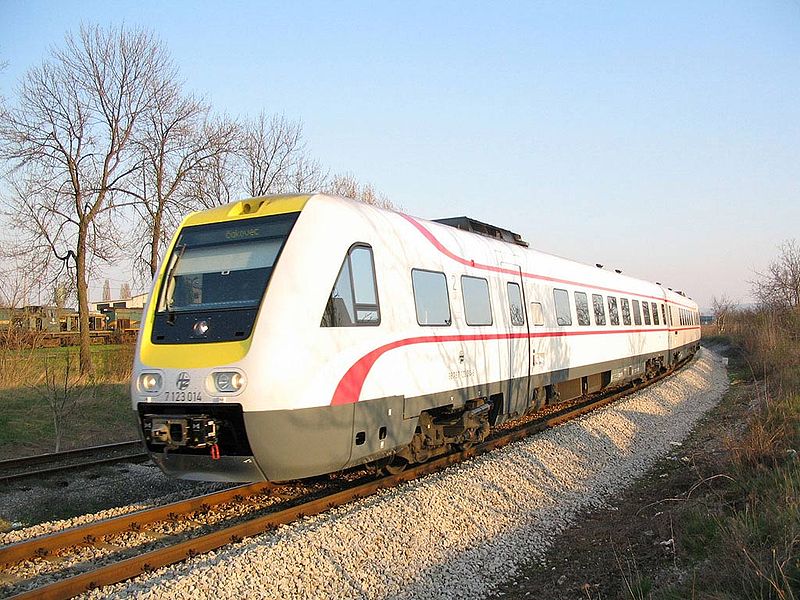
Although there are only two Zagreb train departures for Split each day, as well as one overnight, the afternoon departure fitted my plans perfectly - leaving at 15:20 and arriving at 21:26. Just over six hours on the train versus 5-plus on the bus.
When I first came to Croatia, the trains were fairly dated, but there are some new kids on the block these days, and the train was both modern and spotless.
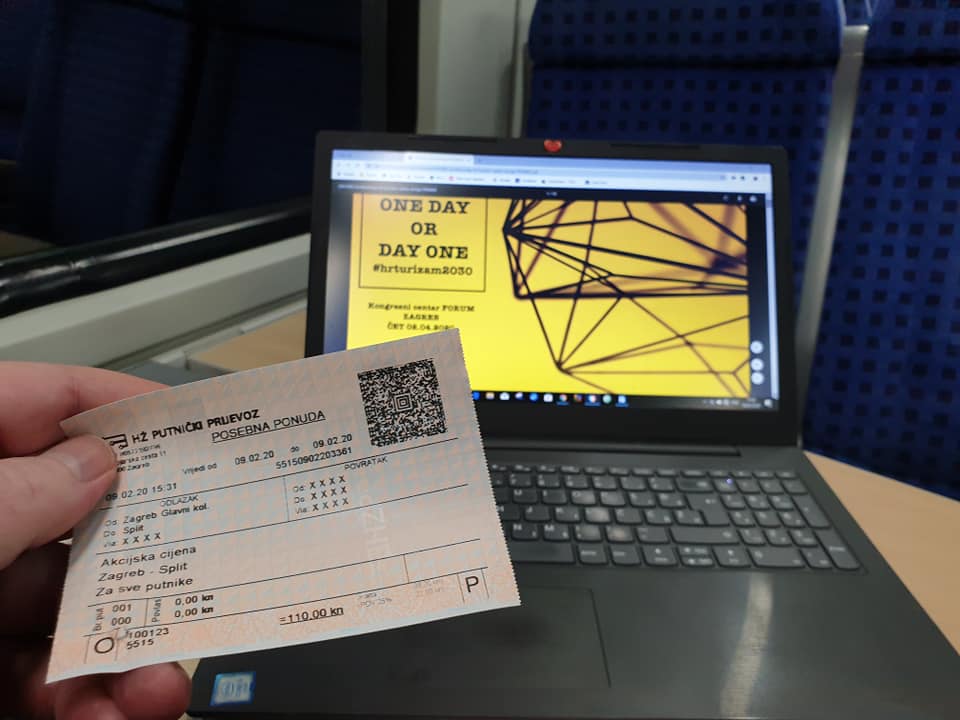
And spacious. With only 6 other people in the entire carriage, I had a table of four all to myself, plenty of time to catch up on the many blogs I need to write for clients, as well as plenty of opportunity to stretch my legs and enjoy the scenery until nightfall came.
And, at just 110 kuna one way, it is significantly cheaper than the bus. I got more than 4 hours of work done before my laptop battery died - sadly there are no plugs available.
There are also no refreshments, but a little forward thinking can overcome that problem.
We arrived, just 10 minutes late, in Split, with me feeling refreshed from the extra space unavailable on the bus, as well as feeling accomplished on 4 hours of work completed. Something that would never happen on the bus, or driving.
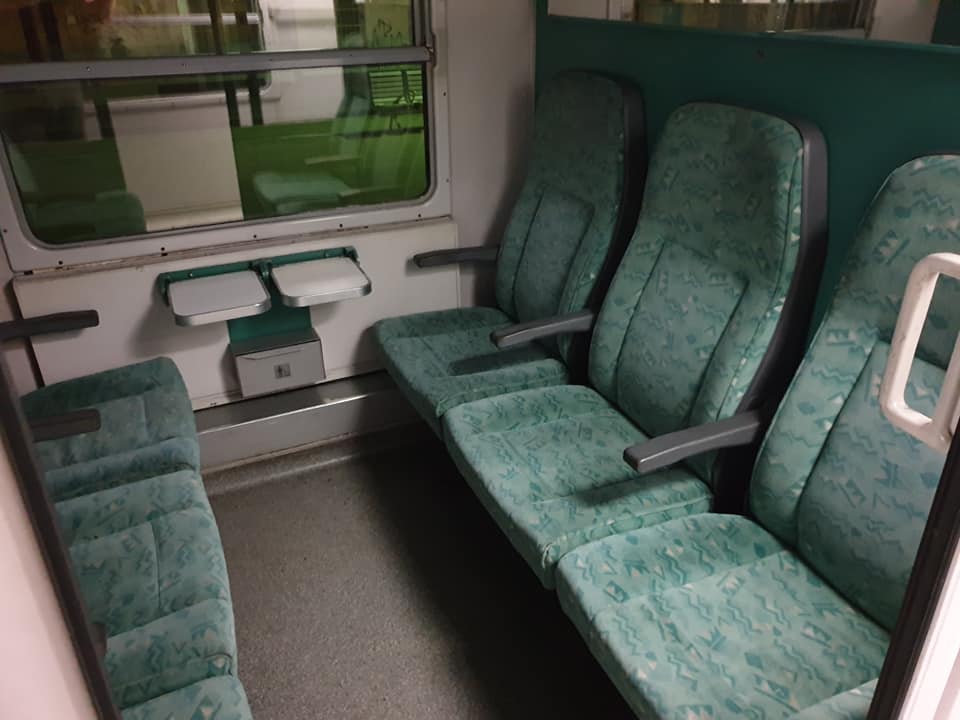
And after a successful three days in the Dalmatian capital, the return journey.
I love taking the overnight Zagreb train from Split for a number of reasons. The main reason is time, the one thing I lack most in life. The reality is that commuting between Split and Zagreb takes out a good chunk of the day and is therefore quite inefficient. The night train - also just 110 kuna currently - leaves at just before 10pm and arrives around 6am. It is almost always deserted, and I have never failed to get a whole cabin, such as the one above, to myself. The trains are heated, and apart from a ticket check within minutes of departure, there are no other disturnances, and a sound night of sleep ensues. An early morning coffee in Zagreb and a shower at a friend's apartment, and a full working day in the Croatian capital awaits.
For more options on how to get from Zagreb to Split, check out the Total Croatia guide.
Flights to Croatia: Croatia Airlines Confirms New Zagreb Services to Sofia, Podgorica
February 12, 2020 - Croatian national carrier and Star Alliance member Croatia Airlines is introducing new international flights from Zagreb to Sofia and Podgorica this summer.
Namely, Avio Radar reports that regular international flights from Zagreb to Sofia are scheduled from May 1 to the end of October this year. This service will run three times a week, on Mondays, Wednesdays and Fridays, and will operate using the 76-seater Dash 8-Q400 aircraft.
Two days later, on May 3, 2020,regular international flights on the Zagreb-Podgorica route will be introduced on Tuesdays, Thursdays, and Sundays. Flights will also be operated by the Dash 8-Q400 aircraft. As of today, return airline tickets are sold on both routes.
Compared to the last tourist season, where Croatia Airlines had a fleet of 14 aircraft (12 of their own and 2 chartered CRJ 1000 aircraft), they will enter this season with one additional aircraft. Based on a long-term dry lease, the fleet will include a 150-seat Airbus 319 in late March and an additional 76-seat Dash 8-Q400 in late April to support unplanned traffic disruptions. In addition, from April to October, a short lease (wet-lease) of one CRJ 1000 aircraft by the Spanish air carrier Air Nostrum is also planned.
Thus, the company will have a fleet of 15 aircraft this year (two Airbus 320s, five Airbus 319s, seven Dash 8-Q400s, and one CRJ1000 aircraft).
Croatia Airlines aircraft will fly scheduled flights to 40 destinations in 26 countries during this tourist season, thus continuing to contribute to regular and year-round connectivity in domestic and international air transport, as well as provide strong support to the development of Croatia’s tourism potential.
Furthermore, Croatia Airlines is also looking to hire new cabin members to cover its expanding fleet and route network. President of the Supervisory Board Zlatko said on Ex Yu Aviation:
“Croatia Airlines is a decent and high-quality Central European company, whose strategic goals are, first and foremost, quality and passenger safety. In the words of our owner, the government of the Republic of Croatia, the expansion of our destination network, as well as fleet renewal, is our strategic focus in the upcoming period”.
To read more about travel in Croatia, follow TCN’s dedicated page.
Zagreb's Jarun Bridge in Focus Once Again - Project Worth 40 Million Kuna
As Poslovni Dnevnik/VL/Petra Balija writes on the 11th of February, 2020, the Jarun bridge is once again in focus, and in one of the drawers of Zagreb's city government, a projection has been gathering dust since way back in 2007. The documentation wad done by the late Jure Radic and his associates, and his work was selected in a public tender among ten applicants.
On numerous occasions, the Jarun bridge's construction was announced but nothing ever came of it, much like many projects in Croatia. Over time, the citizens of Zagreb began referring to it as a phantom project, which Mayor Milan Bandic mentions every now and then when it's convenient to bring it up.
Now the Jarun bridge project is on the table once again, and at the last session of the Assembly, the mayor said that a request for location permits for the route to him and a new bridge over the Sava had been submitted.
''We were looking for location permits for three sections on the extended Vrapcanska street, which would connect Ilica to Adriatic avenue, which includes the Jarun bridge itself. The first section, which is 1500 metres long, would involve the construction of a bridge, the second section would go from the bridge to Horvacanska road and would be about 1300 metres long, and the third section from Horvacanska to Zagrebacka road, and would include an overpass that would go over Zagreb avenue,'' says Dinko Bilic, head of the city construction office.
The design and technical documentation is being prepared, and location permits are expected by the end of April.
''After the issuance of the location permits, the preparation of the subdivision studies will be initiated, and after their preparation and verification, the project's technical documentation for the aforementioned sections will be submitted to the city office for property and legal affairs, which is expected at the end of summer this year,'' said the head of the construction office, adding that the plan for this year is to design the main and the implementation project.
This is not the first time that a location permit for the Jarun bridge has been issued, the 40 million euro project was also being discussed at this level back in 2011, when the same permit was first issued.
Make sure to follow our dedicated business page for more. If it's just Zagreb you're interested in, give Total Zagreb a follow or check out Zagreb in a Page.

